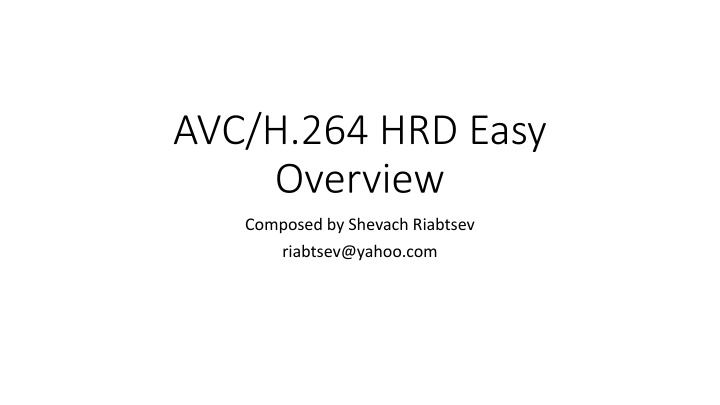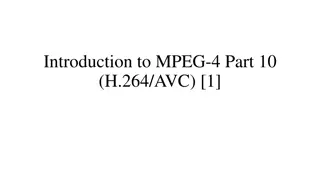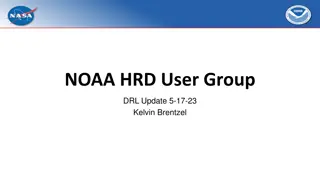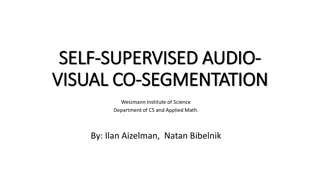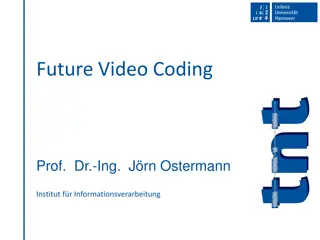AVC/H.264 HRD Easy
Dive into the intricacies of the AVC/H.264 encoding standard, including detailed flowcharts, bitrate specifications, buffer mechanisms, and frame removal processes. Understand how CPB and DPB sizes are determined, the signaling of removal times, and the hypothetical nature of the HRD model.
Uploaded on Feb 16, 2025 | 0 Views
Download Presentation

Please find below an Image/Link to download the presentation.
The content on the website is provided AS IS for your information and personal use only. It may not be sold, licensed, or shared on other websites without obtaining consent from the author.If you encounter any issues during the download, it is possible that the publisher has removed the file from their server.
You are allowed to download the files provided on this website for personal or commercial use, subject to the condition that they are used lawfully. All files are the property of their respective owners.
The content on the website is provided AS IS for your information and personal use only. It may not be sold, licensed, or shared on other websites without obtaining consent from the author.
E N D
Presentation Transcript
AVC/H.264 HRD Easy Overview Composed by Shevach Riabtsev riabtsev@yahoo.com
General Flowchart General Flowchart AVC/H.264 spec. Signaled removal ES BitRate TS (MB) Buffer CPB DPB ES Reconstr. picture Instantaneous Decoder Signaled Removal Signaled Removal
Details Details CBP Size (in bits) is specified in VUI via cpb_size_value_minus1 and cpb_size_scale as CpbSize = ( cpb_size_value_minus1+ 1 ) <<(4+ cpb_size_scale) The bitrate (bits per second) is specified in VUI via bit_rate_value_minus1 and bit_rate_scale as BitRate = (bit_rate_value_minus1+1)<<(bit_rate_scale+6) DPB Size granularity is in units of frames and specified in VUI by max_dec_frame_buffering, if this parameter not present derived from Table A-1 of the spec. according to level Removal Time from DPB is specified in picture timing SEI by dpb_output_delay, this parameter is signaled for each picture. Frame is removed from DPB instantaneously. Removal Time from CPB is specified in picture timing SEI by cpb_removal_delay, this parameter is signaled for each picture. Frame is removed from CPB instantaneously. Note: Frames are removed from CPB instantaneously and immediately decoded instantaneously and put onto DPB instantaneously. In other words a frame moves from CPB to DPB in 0 seconds. Therefore HRD model is called Hypothetical.
Details and Notes Details and Notes TS buffer is not specified in H.264/AVC. However, it s specified in Blu-Ray spec. (named as MB1 or Multiplexor buffer) and it has a constant size of 40000 bytes (Table 8-3 of Blu-Ray spec). The input rate to TS buffer is leak rate (the rate is specified in Table 8-2 of Blu-Ray spec). For level 4.1 the input rate is 1.2*40*10^6 bits/sec. cpb_removal_delay denotes the frame removal time (in units of clock ticks, details are present in the next slide) from the last buffering period SEI. Thus, cpb_removal_delay is monotonically increasing along frames until next buffering_period SEI message encountered. The number of bits allocated for cpb_removal_delay is specified by the VUI parameter cpb_removal_delay_length. One should choice the magnitude of cpb_removal_delay_length such that no wrap-around occur within the maximal buffering-period interval. For example, if we specify cpb_removal_delay_length=8 bits and the frame duration is 2 clock ticks, but the number of frames between two buffering period SEIs is greater than 512 then we can t keep cpb_removal_delay monotonically increasing.
When Frames Removed from CPB? When Frames Removed from CPB? Frame is removed from CPB according to cpb_removal_delay (signaled in the pic_timing SEI associated with the given frame). cpb_removal_delay is specified in units of clock ticks from arrival of the last buffering_period SEI Clock Tick (Tc) is derived from num_units_in_tick and time_scale (signaled in VUI) as Tc = num_units_in_tick /time_scale Tc also specifies the duration of field in seconds, hence the duration of frame is 2 x Tc seconds. To convert cpb_removal_delay to seconds use the following: cpb_removal_delay * Tc The removal time Tr( n ) of the frame #n from CPB is specified as follows: Tr( n ) = Tr( last buffering period ) + tc * cpb_removal_delay( n ) Usually the buffering period SEI is signaled at the start of GOP (not necessarily each GOP)
When Remove Very First Frame from CPB? When Remove Very First Frame from CPB? The initial removal time ( or removal time of the very first frame) in seconds is specified by initial_cpb_removal_delay/90000, where initial_cpb_removal_delay is signaled in buffering_period SEI.
When Data starts to Flow to TS buffer and Restrictions ? When Data starts to Flow to TS buffer and Restrictions ? The start time (Big Bang) is specified by the first PCR arrived, from that event data flows to TS buffer and is drained to CPB with the predefined rate BitRate (remind TS-buffer is leaky). Only after initial_cpb_removal_delay/90000 seconds Decoder starts to work, i.e. to remove data from CPB. Thus, the decoding delay is equal to initial_cpb_removal_delay/90000 . Blue-Ray standard limits the maximal decoding delay to 1 sec., i.e. initial_cpb_removal_delay < 90000. The maximum delay of 1 second puts some restrictions on CPB size and BitRate. If we divide a declared CPB buffer size (CpbSize) with a declared bit-rate (BitRate) then the result must be less or equal to 1, if not, either the buffer size should be reduced or BitRate should be increased.
More Relevant Definitions More Relevant Definitions Ta(n) - the time when the first bit of the picture #n enters the CPB, called the arrival time of picture #n. Tf(n) - the time when the last bit of the picture #n enters the CPB, called the final arrival time of the picture #n. Tf(n) is equal to Ta(n)+PictureSize/BitRate. Tr(n) the time when the picture #n is removed from the CPB, called the removal time.
VBR and CBR Modes VBR and CBR Modes CBR signaled by cbr_flag=1 in VUI. In this mode data from TS buffer flows with a constant predefined rate BitRate, i.e. the tap between TS and CPB is always open and never closed even for a moment. In CBR mode Ta(n) = Tf(n-1). VBR - signaled by cbr_flag=0 in VUI. In this mode the tap between TS and CPB can be closed temporarily (to prevent CPB overflows), however when the tap is open data flows with constant rate BitRate. Hence, Ta(n) Tf(n-1). Note: in both modes the bit-rate to CPB is specified as BitRate = (bit_rate_value_minus1+1)<<(bit_rate_scale+6) Where bit_rate_value_minus1 and bit_rate_scale are signaled in VUI.
CBR Mode Example CBR Mode Example The figure is taken from JVT-D131 HRD and Related Issues by Eric Viscito Time n n n initial arrival time final arrival time removal time Buffer Fullness Buffer Fullness Curve 0 3 1 2 4 0 0 0 1 1 1 2 2 3 2 3 4 3 4 4
VBR Mode Example VBR Mode Example The figure is taken from JVT-D131 HRD and Related Issues by Eric Viscito Time n n n initial arrival time final arrival time removal time Buffer Fullness Buffer Fullness Curve 4 3 1 2 0 0 0 0 1 1 1 2 2 2 Delays to enforce causal arrival time 3 3 4 3 4 4
How Arrival Time Derived in VBR mode? How Arrival Time Derived in VBR mode? Unlike CBR mode, Ta(n) > Tf(n-1). In other words in the period of [Ta(n) Tf(n-1)] seconds the tap is closed. Before let s specify what is Te(n) earliest time for the picture #n to enter: a) For non-IDR frame Te(n) = Tc*cpb_removal_delay(n) + Tr(last idr) (initial_cpb_removal_delay+initial_cpb_removal_delay_offset)/90000 where Tc = num_units_in_tick /time_scale b) For IDR frame Te(n) = Tc*cpb_removal_delay(n) + Tr(last idr) initial_cpb_removal_delay/90000 The arrival time of frame #n is Ta( n ) = Max( Tf( n 1 ), Te( n ) )
